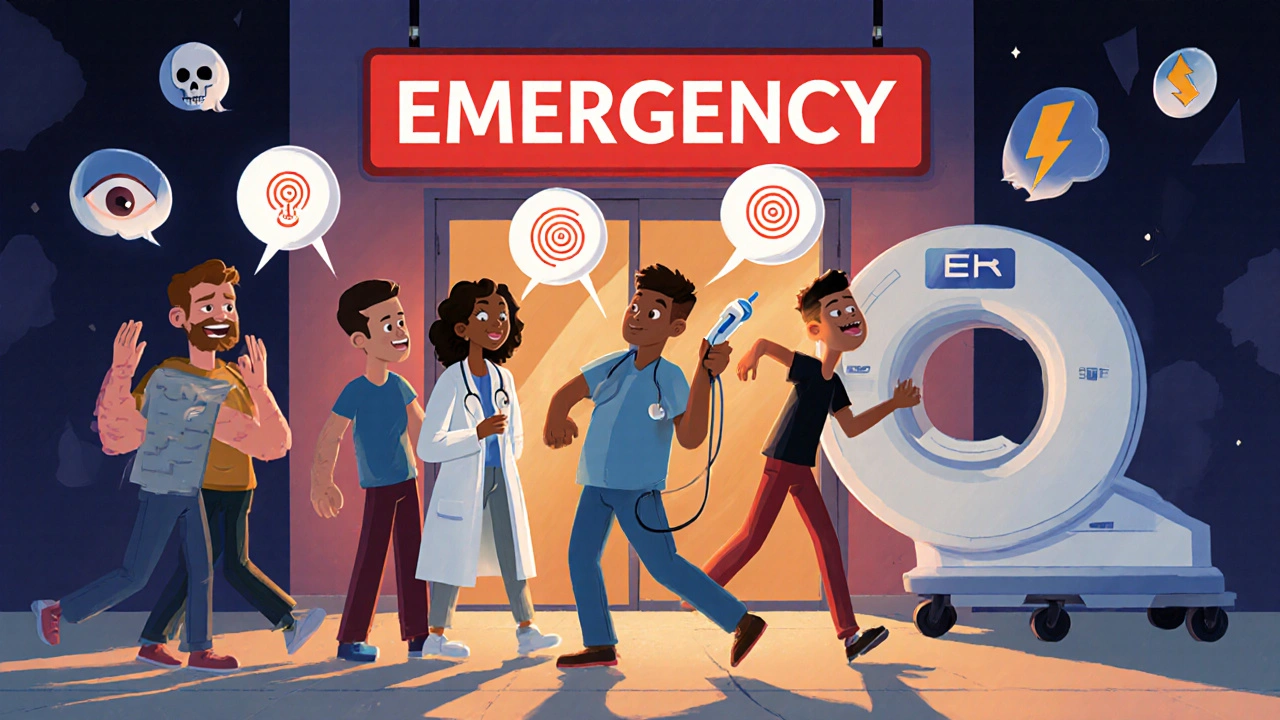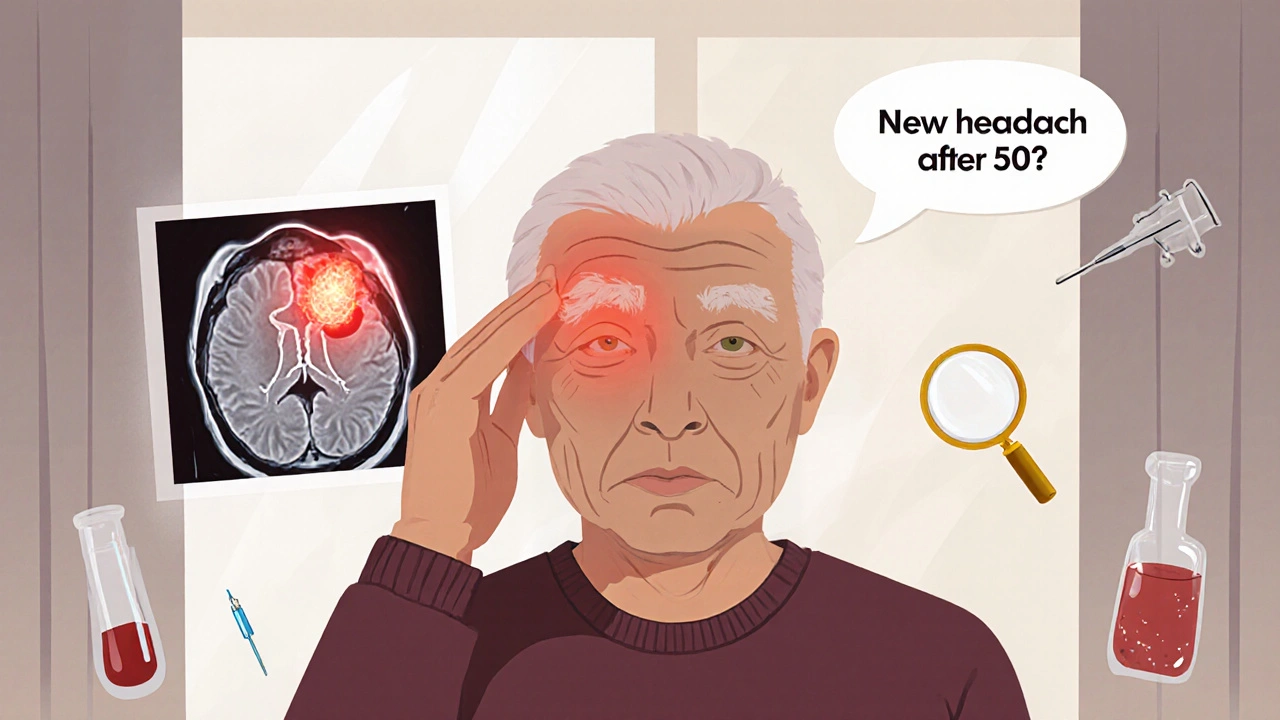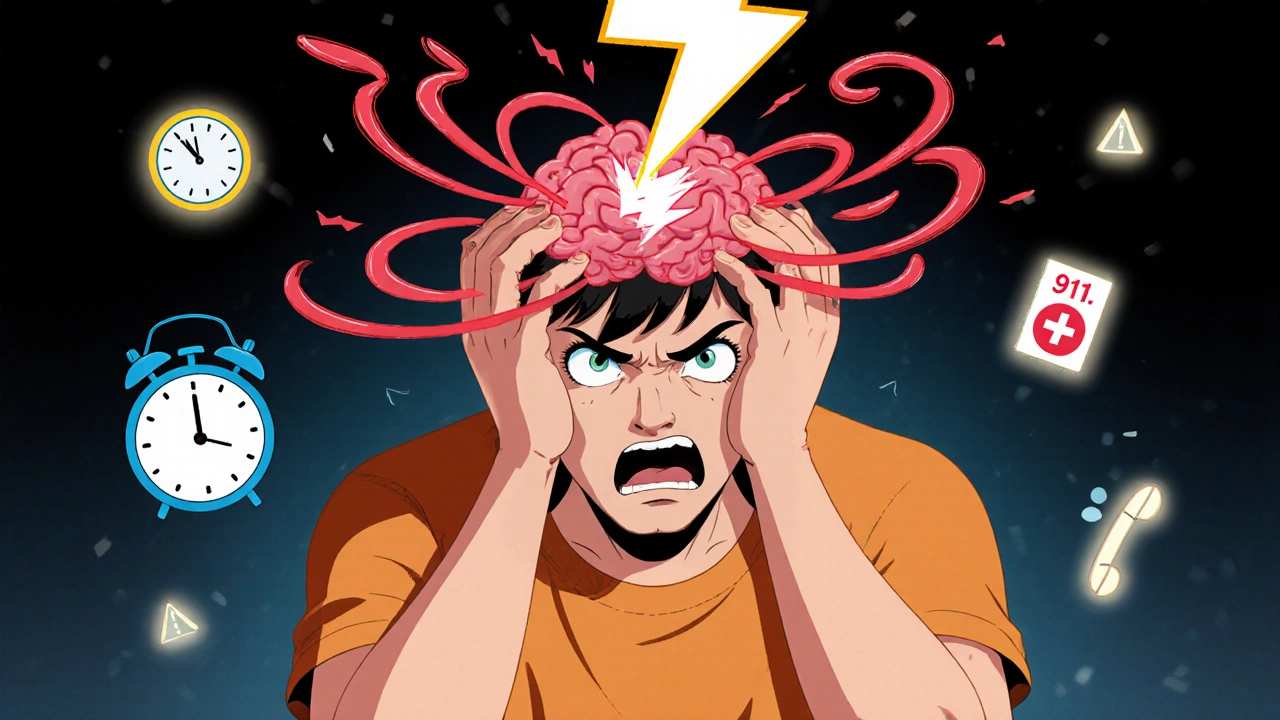Most headaches are just part of life-stress, lack of sleep, or a little too much caffeine. But when a headache comes with certain warning signs, it’s not just a bad day. It could be your body screaming for help. About 50% of adults get headaches every year, but only about 4-5% of those visiting emergency rooms have something serious going on. The problem? Nearly one in five of those serious cases gets missed because the red flags are ignored.
What Makes a Headache Dangerous?
Not all headaches are created equal. A migraine might make you want to lie in a dark room, but it usually builds slowly and comes with nausea, light sensitivity, or visual auras that fade within an hour. A dangerous headache? It hits like a lightning bolt. The most urgent red flag is a thunderclap headache. This isn’t just a bad headache-it’s the worst headache of your life, and it peaks in under a minute. Think of it like a balloon bursting inside your skull. About 85% of people with a ruptured brain aneurysm describe it this way. If you’ve never felt anything like this before, and it hits suddenly, don’t wait. Don’t take ibuprofen and hope it goes away. Call 911.Neurological Symptoms Are the Biggest Warning
Your brain controls everything-movement, vision, speech, awareness. If your headache comes with any of these, it’s an emergency:- Weakness or numbness on one side of your body
- Slurred speech or trouble finding words
- Double vision or sudden loss of vision
- Confusion, drowsiness, or difficulty waking up
- Seizures
Headaches After Age 50? Don’t Brush It Off
If you’ve never had serious headaches before and suddenly start getting them after 50, that’s not normal aging. It could be giant cell arteritis (GCA), a condition where blood vessels in your temples become inflamed. Left untreated, it can cause permanent blindness. The telltale signs? A new, constant, throbbing pain near your temples, jaw pain when chewing (called jaw claudication), and tenderness when you touch your scalp. A 2023 study found that people over 50 with new headaches have a 23-fold higher risk of GCA. And if you’re over 60 and have a headache with fever, weight loss, or fatigue, it’s even more urgent. Blood tests and a biopsy can confirm it-but only if you get checked in time.Fever, Stiff Neck, and Headache? This Is Meningitis
A headache with fever and a stiff neck isn’t just a bad cold. It could be meningitis-an infection of the membranes around your brain and spinal cord. Bacterial meningitis kills 1 in 10 people even with treatment. Each hour of delay increases the risk of death by over 5%. You don’t need to have all the classic signs. Sometimes it’s just a headache, fever, and feeling unusually sick. If you’re immunocompromised-due to cancer treatment, HIV, or long-term steroids-you’re at higher risk for fungal meningitis, which has a 35% death rate even with antibiotics. Don’t wait for the neck to be stiff. If you have a headache and fever and feel worse than you ever have before, get to a hospital.
Head Injury? Headache Alone Isn’t Enough
You bumped your head. You have a headache. You feel fine otherwise. Should you worry? Yes-if you lost consciousness, even briefly. Yes-if you vomited more than twice. Yes-if you’re confused, drowsy, or can’t remember what happened. The NEXUS II guidelines say that if you had a head injury and your Glasgow Coma Scale score dropped by two or more points, you need a CT scan within an hour. Even if you’re young and healthy, a bleed inside your skull can develop slowly. You might feel okay for hours, then crash. That’s why doctors don’t just ask, “Did you hit your head?” They ask, “Did you feel different afterward?” If the answer is yes, don’t go to sleep. Get checked.Papilledema: Swelling Behind the Eye
This one is rare but critical. Papilledema means swelling of the optic nerve, visible only through an eye exam. It’s caused by increased pressure inside the skull-often from a tumor, infection, or fluid buildup. You might not notice it yourself, but you could have blurred vision, double vision, or temporary vision loss. If your doctor sees papilledema, they’ll order an MRI immediately. CT scans miss 22% of these cases. That’s why MRI is now the standard for anyone with unexplained headaches and vision changes.What About Cancer or Immunosuppression?
If you have cancer-or you’re on chemotherapy, steroids, or drugs that suppress your immune system-a new headache is not something to monitor at home. It could mean cancer has spread to your brain, or you’ve developed a fungal infection like cryptococcal meningitis. The American College of Emergency Physicians says these patients need evaluation immediately, regardless of other symptoms. A 2023 Lancet study found that 32% of cancer patients with new headaches had brain metastases. Early detection can mean the difference between treatment and palliative care.What Doesn’t Count as a Red Flag?
Let’s clear up some myths. Migraines with aura? They’re scary, but they’re not emergencies. The visual disturbances-flashing lights, blind spots, zigzag lines-usually build over 5 to 20 minutes and fade within an hour. Stroke symptoms, by contrast, come on suddenly and don’t improve. Tension headaches? They’re dull, constant, and feel like a band around your head. They’re not dangerous. Cluster headaches? They’re excruciating, but they’re predictable, come in cycles, and don’t cause neurological damage. The key is change. If your headache pattern suddenly shifts-new location, new severity, new symptoms-that’s when you need to act.
What Should You Do If You Notice a Red Flag?
Don’t drive yourself. Call 911. Emergency responders can start life-saving treatments on the way. In the ER, they’ll check your vitals, do a quick neurological exam, and order imaging-usually a non-contrast CT scan within 30 minutes for thunderclap headaches. If the CT is normal but suspicion is still high (like with thunderclap headache), an MRI or spinal tap might follow. For suspected meningitis, antibiotics are given within 45 minutes of triage. For stroke, clot-busting drugs can be given up to 4.5 hours after symptoms start-but only if you get there fast enough.Why Do People Delay?
A 2023 survey by the National Headache Foundation found that 63% of people with thunderclap headaches dismissed them at first. Many thought it was just a migraine. Others were afraid of overreacting. One Reddit user wrote: “I ignored my thunderclap headache for four hours. Turned out to be a ruptured aneurysm. The delay increased my risk of rebleeding by 40%.” Fear, denial, and lack of awareness are the biggest barriers. But the data is clear: early action saves lives. Patients who sought help within an hour of red flag symptoms were 78% more likely to avoid permanent disability than those who waited.What Can You Do Now?
You don’t need to be a doctor to recognize danger. Memorize this simple rule: If your headache comes with confusion, weakness, vision loss, or comes out of nowhere like a thunderclap-call 911. Talk to your family. Share this with older parents. Post it on your fridge. The American Headache Society’s ‘Know Your Red Flags’ campaign found that 68% of people who learned these signs were able to act faster the next time. Your brain doesn’t warn you with a siren. It whispers-until it’s too late. Pay attention to the whispers.Is a thunderclap headache always a sign of a brain aneurysm?
Not always, but it’s the most common sign of a ruptured brain aneurysm, which is life-threatening. About 85% of subarachnoid hemorrhages present as thunderclap headaches. Other causes include reversible cerebral vasoconstriction syndrome (RCVS), pituitary apoplexy, or stroke. Regardless of the cause, thunderclap headache is a medical emergency requiring immediate imaging.
Can a headache be a sign of a brain tumor?
Yes, especially if it’s new, worse in the morning, wakes you up from sleep, or gets worse with coughing, sneezing, or bending over. Headaches from brain tumors usually progress over weeks or months. They’re often accompanied by nausea, vomiting, vision changes, or seizures. While brain tumors are rare, new-onset headaches in people over 50 carry a 1 in 200 risk of a tumor, with glioblastoma being the most common malignant type.
Should I go to the ER for a headache after a car accident?
Yes-if you lost consciousness, even briefly, or if you have vomiting, confusion, dizziness, or worsening headache. The NEXUS II criteria say that after head trauma, you need a CT scan if you have any neurological symptoms or if you were unconscious for more than 5 minutes. Don’t wait to see if you feel better. Bleeding inside the skull can develop slowly.
Are migraines with aura dangerous?
Migraines with aura are not emergencies, but they do slightly increase your long-term risk of stroke, especially if you smoke, use birth control pills, or are over 40. The aura itself-flashing lights, numbness, speech trouble-builds slowly over 5-20 minutes and fades within an hour. Stroke symptoms come on suddenly and don’t improve. If you’re unsure, treat it as an emergency until proven otherwise.
What if I have a headache and I’m on immunosuppressants?
Any new headache while on immunosuppressants requires immediate evaluation. You’re at higher risk for fungal meningitis, which can be fatal even with treatment. The mortality rate is 35%, and symptoms can be subtle-just a headache and mild fever. Don’t wait for a stiff neck or high fever. Go to the ER as soon as the headache starts.
Can AI help diagnose headache red flags?
Yes. The FDA-cleared HeadacheAI platform analyzes patient-reported symptoms with 89% accuracy in identifying red flags-better than general practitioners, who correctly identify them about 76% of the time. While AI isn’t replacing doctors, it’s being used in emergency departments and telehealth apps to help prioritize cases and reduce missed diagnoses.
Is it safe to wait and see if a headache goes away?
Only if the headache is familiar, mild, and matches your usual pattern-like a tension headache after a long day or a migraine you’ve had before. If it’s different, worse, or comes with neurological symptoms, waiting is dangerous. For thunderclap headaches, meningitis, or stroke-related headaches, every minute counts. Delaying care increases the risk of death, disability, or permanent brain damage.







11 Comments
headaches rnt that big of a deal unless u start seeing zigzag lines and hear voices lol
theyre hiding the real cause-5G towers and chemtrails are raising intracranial pressure. the docs dont wanna admit it because they get paid to treat symptoms, not cure the truth. i saw a video on youtube where a guy cured his thunderclap headache with Himalayan salt and a copper hat. no joke.
It is profoundly concerning that the medical establishment continues to rely on outdated paradigms when neurological emergencies are concerned. The systemic failure to prioritize rapid imaging protocols in primary care settings is not merely negligent-it is a structural betrayal of public trust. We are not merely discussing clinical outcomes; we are discussing the erosion of civic responsibility in healthcare delivery.
Interesting that the article mentions HeadacheAI-have you seen the latest peer-reviewed data on its false positive rate in elderly patients with vascular dementia? The sensitivity is impressive, but specificity drops to 68% in those over 70. We need better calibration, not just deployment.
my aunt ignored her headache. now she’s blind. don’t be her.
In India, we say: "The head is the temple of the soul." When it screams, we must listen-not with fear, but with reverence. A headache is not just pain; it is the body’s ancient language, begging to be understood. Modern medicine gives us scans and drugs, but wisdom? Wisdom comes from stillness, from knowing when to run and when to rest.
My grandfather had a thunderclap headache at 62. He refused the hospital. Two days later, he woke up speaking in tongues. The doctors called it a stroke. I call it the soul trying to escape before the vessel broke.
if you’re reading this and you’ve been ignoring that weird headache-just go. i know it’s scary, i know you think it’ll go away, but trust me: the ER waiting room is way better than the alternative. you don’t need to be brave, you just need to be smart.
Let’s be precise: the article inaccurately conflates reversible cerebral vasoconstriction syndrome (RCVS) with subarachnoid hemorrhage (SAH) in terms of diagnostic urgency. RCVS is a benign, self-limiting condition in 90% of cases-yet the conflation promotes unnecessary CT scans, increasing radiation exposure and healthcare costs. This is misinformation dressed as public service.
Furthermore, the claim that "AI outperforms GPs" is statistically misleading. The study cited used curated, high-fidelity data inputs; real-world GP encounters involve incomplete histories, patient anxiety, and comorbidities that degrade AI performance by up to 32%. This is dangerous oversimplification.
And let’s not forget: the FDA cleared HeadacheAI as a decision-support tool, not a diagnostic device. The author’s phrasing deliberately blurs regulatory boundaries. This is not advocacy-it’s negligence disguised as empowerment.
The notion that one must immediately call 911 for any atypical headache reflects a profound misunderstanding of medical triage. Emergency resources are finite, and the normalization of hyper-vigilance erodes the credibility of true emergencies. One does not summon an ambulance for a headache that resembles one’s migraines, merely because it occurred after a stressful meeting.
Moreover, the article’s assertion that "your brain whispers until it’s too late" is emotionally manipulative. The brain does not whisper-it signals, through patterns, through history, through context. To reduce complex neurology to a fairy tale of silent warnings is to infantilize the patient.
True medical literacy is not about panic-it is about discernment. Know your baseline. Track your symptoms. Consult your physician. Do not surrender autonomy to the siren song of emergency services.
And yet… I suppose if one has a family history of aneurysms, or is over 50 with new-onset pain… perhaps, just perhaps, one might consider a call to the neurologist before the ambulance.
thank you for writing this. i used to brush off my mom’s headaches until she had a stroke. now i keep a list of red flags taped to her fridge. if you’re reading this and you’re scared to make a fuss-do it anyway. your loved ones will thank you.
Thank you, Karen. That’s exactly the right approach-compassion without panic. I’ve seen too many families paralyzed by fear, and too many ignored by systems that don’t listen. The goal isn’t to turn every headache into a crisis. It’s to ensure the real ones don’t slip through.